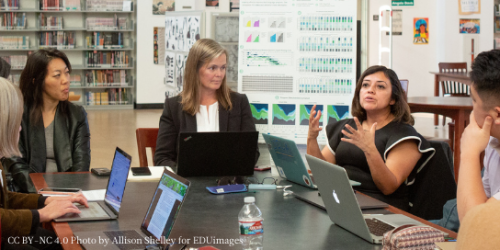Teacher impact = (teacher talent*time)^collaboration
The 2016 survey by the Center on Education Policy “Teacher Views and Voices” asked teachers to name the actions their districts could take to help them most in their day-to-day teaching. “More planning time during the school day” was the main factor identified as helpful to improve the quality of their teaching.
During the last school year, as teachers juggled different and changing modalities of instruction, time to plan their lessons and make them impactful in multiple settings was as critical as ever. The same can be said for teacher collaboration: the sharing of knowledge and strategies has been crucial for teachers to effectively reach students, and the most successful teachers rarely go it alone. As schools and teachers work to help students recover from “unfinished learning” of the last year, both individual and collaborative planning time will be vital to be able to meet individual student needs.
As districts begin to plan what the next school year will look like, this District Trendline analyzes how teacher planning and collaboration time are currently being addressed by the 100 largest school districts in the United States plus the largest district in each state not otherwise included, for a total of 121 districts.
Planning time
The time that a teacher has during the school day to plan lessons has not changed significantly over the last decade. The vast majority of districts grant their teachers time roughly equivalent to one class period per day for the purpose of planning: 47 minutes on average for elementary school teachers, and 51 minutes for secondary teachers. This is only two minutes longer than the average planning time that teachers in elementary grades had in 2015, and no real difference for teachers in secondary schools.
Apart from indicating the amount of planning time, less than half of the districts in our sample go on to spell out specifics, such as if the school is required to provide uninterrupted planning. Burlington School District (VT) stands out for clearly specifying that the 45 minutes of planning time must be continuous.
Other districts, such as the District of Columbia Public Schools, only indicate planning time in terms of “periods.” Since the average class period in the United States ranges from 45 minutes to an hour, it has been assumed that the time that those districts allocate to their teachers for planning purposes falls within that range.
Still, we find some movement among the districts over the last five school years, with slightly more of them being less ambiguous about the details. Since 2015, the percentage of districts in our sample that specify the amount of planning time that elementary school teachers ought to have on a daily basis has increased from 77% to 85%. In the case of secondary teachers, the percentage increased from 70% of the districts in our sample to 81%.
Secondary teachers in Fresno Unified School District (CA) get the most planning time, with an average of 96 minutes per day. Long Beach Unified School District (CA) stands at the other end of the spectrum, providing their elementary school teachers only 40 minutes per week, which amounts to 8 minutes of planning time per day.
Alpine School District (UT), Guilford County Schools (NC), Springfield Public School District (MO), and West Ada School District (ID) state in their governing policies that schools should provide their teachers with planning time, but do not specify the amount of time.
The 2020-21 school year has been atypical in many ways, and planning time was not the exception. Many districts issued MOUs to address reopening during the coronavirus pandemic, which often included reduced in-person or synchronous instruction, as well as additional time for teachers to plan or reach out to students and families one day per week. A New England study from the Center for Reinventing Public Education (CRPE) found this was the case with 43% of the districts in the New England region.
What did teacher collaboration policies look like during the year of the pandemic?
Writer and business consultant Kenneth Blanchard coined the phrase “none of us is as smart as all of us.” At the beginning of the pandemic and the turn to virtual education, teachers understood this promptly, and shared resources with each other, leveraging each other’s strengths.
Many districts’ official policies do not reflect Blanchard’s advice, as collaboration policies look pretty much the same as they did before the pandemic. About half of the districts in our sample do not address the topic, and only a fifth of the districts set specific time aside during the school day for teacher collaboration.
Some districts, such as Metropolitan Nashville Public Schools (TN), allow teachers to decide for themselves if and to what extent they use their planning time for collaboration with colleagues. In other cases, the availability of collaborative time depends on the school’s leadership, such as in Baltimore City Public School System (MD), where principals may designate one of the teachers’ preparation periods per week for collaborative planning. Other districts are less specific, such as Charlotte-Mecklenburg Schools (NC), where policy states that teachers should be given “regularly scheduled opportunities to meet in teams to develop lesson plans and otherwise collaborate with their colleagues,” but these opportunities are not defined.
Recommendations
Scholars have identified the importance of teacher collaboration not only on student achievement, but also on teacher satisfaction. Pil and Leana (2009) found that only part of a student’s success is tied to the teacher’s individual talent. Instead, they found that “horizontal tie strength” (i.e. synergy) among teachers were bigger predictors of student improvement.
As districts plan what their 2021-22 school year will look like, the role of planning and collaboration should not be overlooked. Districts that have not done so ought to first, consider defining both teacher planning and collaborative time, and second, ensure these time blocks are not unduly compromised. A school is stronger and better able to serve its students when teachers can work together, and this is particularly true in more challenging environments.
There are, of course, challenges to overcome. Increasing a teacher’s planning time can be costly for districts. There is also a tension between planning and collaboration time, and the instructional time needed to bridge learning gaps. In her 2016 study, researcher Eileen Merritt suggests some cost effective ways to achieve more planning time for teachers, such as shortening the school day for students, or embedding more teacher work days into the school calendar. District and school administrators have already demonstrated their ingenuity in generating extra planning time when necessary. In addition, administrators can help and guide their teachers in making the most out of their time. This, Harvard scholar Susan Moore Johnson suggests, enables an environment in which teacher quality can increase and teachers can thrive.
More like this

Leave and health insurance for teachers: safeguards amid COVID-19 worries
In the absence of a federal protection, it becomes the jurisdiction of individual districts to lay out protocols.

Supporting teachers through mentoring and collaboration
As school districts work out next year’s instructional format and take stock of their teacher workforce, districts in a position to hire are also readying themselves for a potentially unprepared influx of novice teachers.

